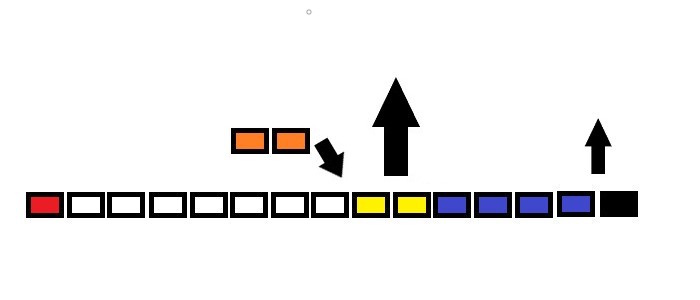ManualLog – LM&O Freight Flow – 5/26/2022
ManualLog – LM&O Freight Flow – 5/26/2022
Given our last few sessions, it’s clear the crews (on the road and in the yard) don’t understand the LM&O’s freight flow. Hopefully this will help them understand. It is your responsibility to make sure that our cargoes enter, cross, and leave our bridge route as intended.
So first, a legend showing car types…

Below shows the basic routing of cars across our railroad.
Blue cars (Bridge Traffic) are nothing more than cuts of cars that travel endlessly between Martin and Calypso yards. You pick these cars up at the first yard you come to and drop it off at the second. These are always detailed on switchlists.
Yellow cars (Inbound cars) are freights for local destinations coming on to the division. These are always denoted with individual waybills. You pick up these bills in staging and drop them at Martin Yard (want to know more? At this point, they are placed on locals and sent out to Shelfton, Mingo, Zanesville and Carbon Hill.)
Orange Cars (Outbound cars) are loads leaving our division. These are always denoted with waybills with routing information PUNCHED OUT to show they’ve already been serviced at their on-division industry. They always leave for Cincinnati or Bound Brook.
The lower illustration shows the yellow cars coming into Martin Yard, and the orange cars leaving. The blue cars continue their endless cycle between Martin and Calypso. (What to know more? This lengthens our trains through the mountains to sizes longer than we can store in staging ).

So let’s follow two trains, one east, one west. This will show how switching occurs in both yards.
Train 202, East out of Cincinnati
Martin Yard
When 202 arrives in Martin Yard, it is moving towards the LEFT (note the location of engine and caboose). The following occurs:
- The head end power picks up the bridge cars off the east end of track 4.
- Meanwhile, the switcher pulls off the tail-end inbound cars. These are sorted onto the local tracks (tracks 1-3).
- Then the switcher tacks on outbound cars off track 6 onto the end of the train.
What the crew gives the yardmaster: The waybills for the inbound cars.
What the yardmaster gives the crew: The waybills for the outbound cars and the switchlist for the bridge cars.

Calypso Yard
Once Train 202 clears the summit at Harris Glen, it rolls downgrade to Calypso. This yard has no dedicated switcher but the work here is easy. The crew needs to just drop the bridge cuts off. The outbound cars stay with the train to Bound Brook.
So now the train is pointing to the right. The move is simple.
- The head end power drops the cars off on the east side of the yard, on track 6 as listed on the switchlist.

Train 223, West out of Bound Brook
Calypso Yard
The train pulls into Calypso and does their own switching. They have only one task:
- The head end power adds the bridge cars off track 6 to the front of their train, right in front of their waybilled inbound cars.
What the crew picks up: The switchlist for the bridge cars they are taking (they should already have the inbound waybills from staging)

Martin Yard
This is the most difficult switching of all the freights and it’s still not much. With the train moving towards the right, the following takes place.
- The head end engines pull the bridge cars off and pushes them into track 4, remaining clear of the switcher.
- The switcher pulls the inbound cut and spots them onto track 1-3.
- The switcher then adds the outbound cars off track 7 to the head end of the train.
What the crew gives the yardmaster: The switchlist of the bridge cars and the waybills of the inbound cars.
What the yardmaster gives the crew: The waybills of the outbound cars.

Things to note:
- Outside of doing the Pittsburgh Local (a task that can be given to someone else), the yard crew DOES NOT need to go anywhere other than the west yard throat. They should be able to do ALL work within 5 feet of layout. No run-arounds.
- The yard crew should not need to work through piles of switch lists. They should be handling maybe three to five cars at a time and be able to sort the cars onto tracks 1-3. The cars/cards should already be sorted.
- All outbound cars are pulled right off the end of their tracks. Often they come per-seperated. Grab and go.
- The yard crew should make sure that paperwork is placed in the correct pockets on top of the existing cards when spotting. Spot a car, put a card in the pocket.
- The yard crew HAVE NOTHING to do with the locals. Locals pick up their cuts off their tracks, grab the cards and leave. When they return, they spot their cars on track 6 and 7 (outbound cars) from the east (left) end of the yard. This keeps them out of the way of the yard crew AND puts their cars on the correct track BUT NOT IN THE WAY of trains doing pickups.
- Note that the bridge car flow is very simple. In both yards, it works the same. You spot cars on one side and pull from the other side. the cars slowly push down the track. Nothing could be simpler.
Please review this information and keep it in mind. Feel free to ask me questions.
